Bell skirt - a popular model, ideal for both the warm spring-summer and cold autumn-winter seasons. Widely recognized thanks to the work of Christian Dior and his legendary New Look style, this model, captured in photographs of movie legends Marilyn Monroe and Audrey Hepburn, is considered universal and suitable for any type of figure, image and style.
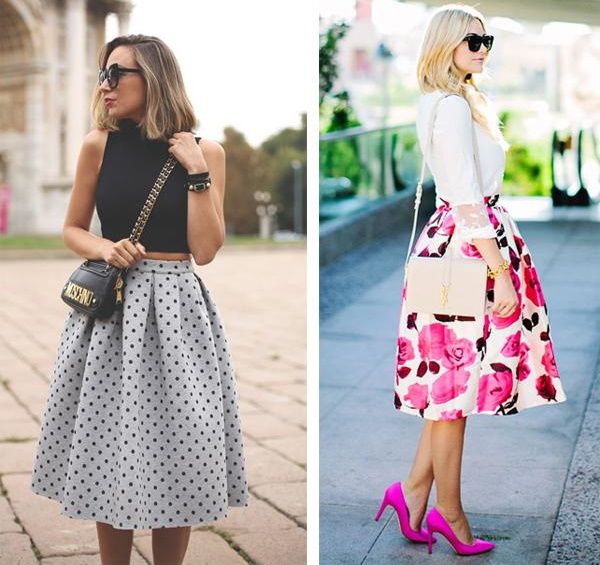
Types
The bell skirt (a photo of the model is given below in the article) dates back to the mid-17th century, but gained real popularity in the 50-60s of the last century, thanks to the "New Look" style developed by Christian Dior. By specially narrowing and emphasizing the waist area, the model draws attention to the advantages of the figure, hides a small belly and excessively voluminous hips.
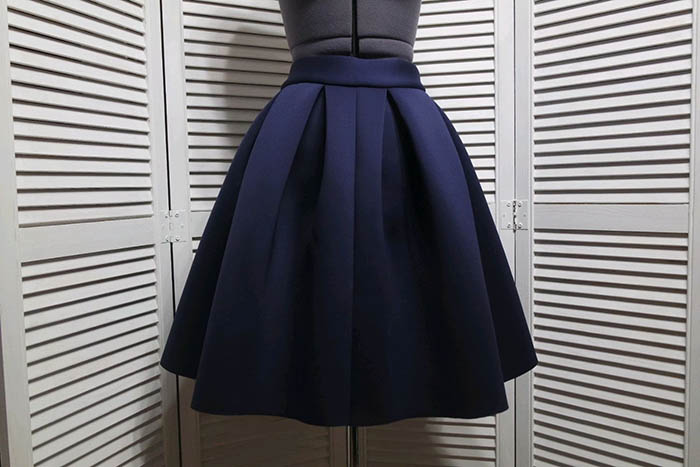
Fashion designer Mary Quant later shortened the full skirt to mid-thigh, creating a model popular with young girls with a high waist, emphasized by a belt, and a straight hem that flares out towards the bottom.
The shape of the bell skirt is selected individually, depending on the body structure, and modern fashion designers distinguish 2 variations of the model:
- Short - a palm-length or more, above the knee. Designers offer this type of clothing for young, slender girls who want to show off the beauty of their legs and accentuate their hips. Professionals recommend combining this model with plain T-shirts, tops or sleeveless blouses. There are also short bell-shaped skirts made of artificial or eco-leather that go well with plain turtlenecks.
- High-waisted midi skirt (to the ankles) is suitable for any age and body type, goes well with classic blouses or T-shirts tucked into a skirt, pumps and cropped jackets.
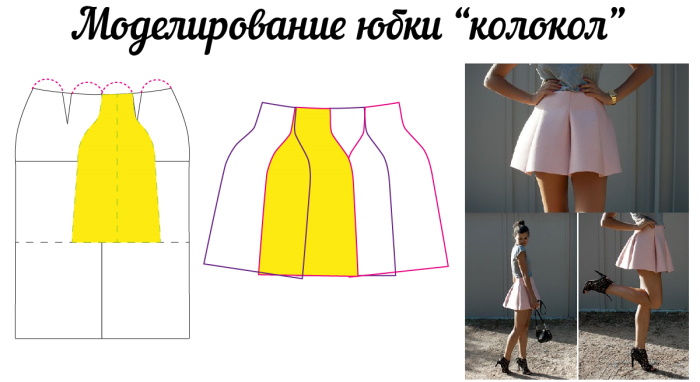
The modern design complemented the classic bell skirt model with bow folds, adding volume to the garment, changed the cut of the belt, decorating it with decoration and adding width.
The bell-shaped skirt model with a yoke allows you to shift the waist and hip area, correcting existing figure flaws and adding elegance to it.
How to choose a model?
A bell skirt (a photo of the classic version of the model can be found in the archives of Hollywood stars of the 20th century) in the classic version is made of dense, well-shaped fabrics: leather, linen, cotton and wool. Jacquard can be used to make a fluffy office skirt, and silk, chiffon or guipure can be used when sewing summer models.
When choosing fabric, designers advise giving preference to monochrome material, made in both pastel and bright colors. It is also permissible to use fabrics with large or small prints for making a bell skirt: flowers, polka dots, small checks. In addition to the original design, this version of the finished product will visually stretch the female silhouette.
Parameters that determine the style of the product:
| Parameter type | How to choose |
| Body type | Designers recommend choosing a classic model of a bell-shaped skirt with a length to the middle of the knee for girls who want to draw attention to the hip area. The style with a thin belt will allow you to visually highlight the waist area, and the model with pockets and a yoke goes well with the "Hourglass" figure type. |
| Length | It is selected depending on the age and height of the woman. Young girls and short women can choose a mini bell skirt with lots of folds. The midi length is suitable for any age and will help hide figure defects. |
| Season | For the cold autumn-winter season, designers offer products made of thick jacquard and wool. For the summer, bell-shaped skirts made of natural, breathable fabrics with a bright print are preferable. |
| Color | Designers call a universal model - a bell skirt with a high waist, made of a single-color material. For the summer season, products with a bright print are suitable, for the winter season - single-color models, checkered and animal prints. |
How to make a pattern
A bell skirt (a photo of the model can be found in Burda magazine) allows you to correct your figure, visually narrowing the waistline and embellishing the lower part of the body.
Before constructing a pattern, you should take certain measurements:
| Type of measurement | How to shoot |
| Waist circumference (WC) | Corresponds to the circle at the narrowest part of the figure. |
| Product length (DL) | Measure along the line from the waist area to the desired end of the product. |
| Hip circumference (HC) | Corresponds to the size of the circumference at the most protruding parts of the hips. |
The model can be cut out either as a single piece or as separate blocks (panels).
The pattern for a bell skirt is made on tracing paper (millimetre paper), and to create it you should:
- from the corner of the paper, set aside a radius R equal to the value of the waist circumference (2-4 cm) and draw the finished circle;
- along the resulting circumference, set aside a segment equal to 1/2 of the OT (waist circumference) value +0.5 cm;
- draw a straight line from the corner through the found point;
- The resulting circumference must be compared with the hip circumference parameters.
The pattern of a bell skirt can also be constructed by analogy with a sun skirt, from which more than half of the panels are removed. The final size of the model here depends on the type of the desired bell: large, medium or small.
The volume coefficient in the hip area is also subject to change. So for a large bell it will be equal to 0.8. For a small one – 1, and 0.9 for the average size. Taking this value into account, you need to construct the radius of the skirt from the center to the edge of the belt, having previously multiplied the required coefficient by 1⁄2 of the OT (waist circumference) value.
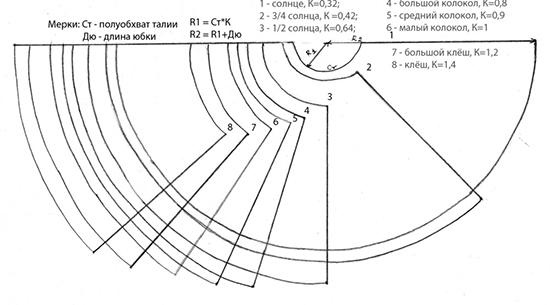
The radius of the waist notch is calculated here using the formula: (OT + 1 cm)/3 * 2 +2 cm.
Materials required for sewing
A bell skirt (photos of the model can be found on popular Internet portals) of midi length for its sewing requires the presence of:
- 2 m of the main dense fabric, 145-150 cm wide;
- 1.5 m of lining fabric with a width of 145-150 cm;
- hidden zipper, 22 cm long;
- threads and needles;
- sewing machine;
- thermal fabrics for strengthening the belt;
- scissors for cutting out the product;
- tailor's chalk or soap;
- pins.
Master class on sewing a mid-length skirt
Before cutting, experts advise performing wet-heat treatment of the fabric, which will prevent possible shrinkage of the product in the future.
To cut out the skirt:
- The material should be folded in half to form a square with sides of 150/150 cm. Each of them should be cut out and folded diagonally.
- The pattern should be placed on the material at an angle (at a 45 degree angle). The fold of the fabric should run along the front and back of the skirt.
- The pattern needs to be transferred to the fabric, taking into account seam allowances of 1.5-2 cm, and cut out.
- The lining fabric should be cut out in a similar manner. The length of the skirt here should be 10-15 cm shorter than the main piece.
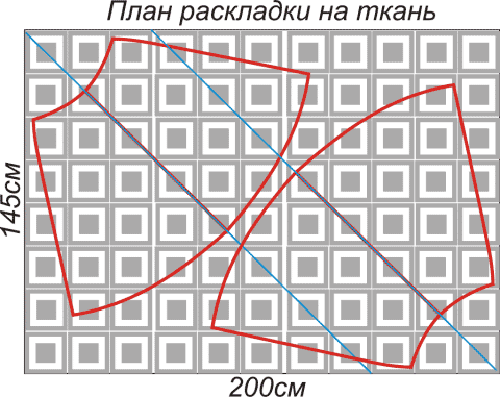
Sewing a skirt:
- All parts of the skirt should be swept manually along the side seams. Before this, the lining part should be placed on the main fabric from the wrong side and, having aligned the parts of the product along the waist line, they should be connected manually. On the left side of the product, 22 cm should be left unsewn, which is necessary to insert the zipper.
- The resulting model should be tried on, if necessary, correct any flaws and lay a machine stitch. The finished seams should be ironed, and the edges processed with an overlock.
- Stepping back 1 cm from the waist line in the center of the back, you need to place the zipper and mark its length (to the end of the teeth).
- To the lining with the skirt along the left side seam, baste a frame under the zipper with a width equal to the width of the teeth, and then lay a machine stitch along the frame. The previously made baste should be removed.
- To make a belt, you need to add 3-4 cm to the waist circumference value and, using the resulting value, cut out a belt rectangle from the main fabric.
- A strip of heat-adhesive fabric should be attached to the resulting part and attached with a hot iron. The resulting belt should be attached to the wrong side of the skirt with the front side and stitched on the machine.
- The belt should be folded in half, its edges turned up and stitched to the front side of the product. A loop should be punched and overcast on one end of the belt, and a button of the appropriate size should be sewn on the other.
- It is recommended to hang the finished skirt on a hanger and leave it for 12 hours to allow the fabric to shrink.
- After the specified time has passed, the model must be tried on, pinned to the desired length and the hemline processed with an overlock.
Mini and maxi bell skirts are made in a similar way. The only difference here is the fabric consumption. So, for a knee-length model, you will need about 1-1.5 m of the main fabric. A maxi skirt requires at least 3 m of fabric for its production.
Master class on making a pleated bell skirt
A bell skirt with pleats diverging from the waist or hips, photos of which can be found in the collections from Couturier brands Chanel, Chapurin and Alexander McQueen, will allow you to emphasize the beauty of your figure and hide its flaws. The pattern for such a model is created on the basis of a classic pattern, but requires a significant increase in the consumption of the main fabric.
To construct a pattern for one of the skirt wedges, you will need the following on tracing paper or a sheet of graph paper:
- Construct a right angle with the vertex indicated by the letter A.
- Calculate the radius of the inner arc, corresponding to the OT value (waist circumference) divided by 6.28. When using the half-waist circumference value, its value should be divided by 3, and 2 should be subtracted from the resulting value.
- From point A, you need to set aside segments in both directions equal to the found radius value, designating the found points with the letters T and T1.
- Using a compass or a rounded template, points T and T1 should be connected with a smooth arc.
- From these same marks on both sides of the angle, you need to draw lines down equal to the value of DI, designating the found points with the values H and H1.
- Points H and H1 should also be connected by a smooth arc.
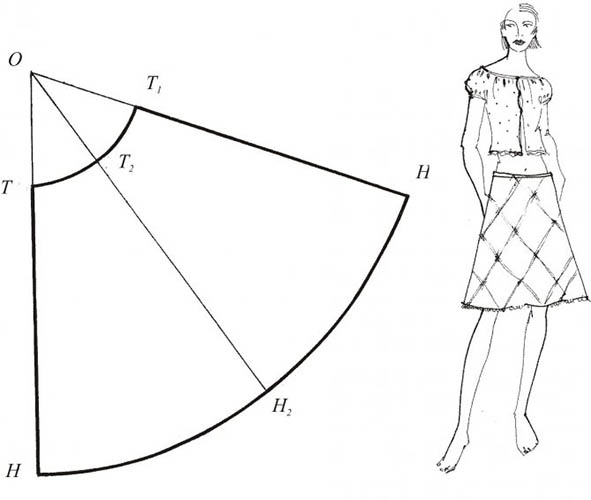
To cut out a bell skirt with one transverse fold, you should:
- Fold the fabric 3-4 times in the direction of the grain line and bend a strip of the width corresponding to the volume of the desired fold along the fold. The resulting fold line should be swept.
- Having placed the pattern on the fabric so that one of its edges coincides with the basting line, you need to transfer the pattern onto the material with soap (tailor's chalk), making sure to leave a seam allowance of 2-3 cm.
- The resulting parts of the product must be cut out and basted manually along the side seams. On one of them, a distance of 22 cm must be left unsewn.
- The preliminary layout of the product should be tried on, adjusted if necessary, and then machine stitched.
- A zipper needs to be sewn into the section left on the seam, having first tacked it to the wrong side of the skirt.
- The resulting seams should be ironed and the edges processed with an overlock.
- The fold that has formed on the skirt must be ironed and stitched along the top of the product.
- To make a belt, cut out a rectangular piece of fabric with a width equal to the OT value + 3(4) cm.
- The front part is applied to the back side of the skirt and machine stitched. After folding the belt in half, it needs to be folded and sewn to the skirt with the front side. If desired, the belt strip can be reinforced with thermal fabric before attaching to the main product.
- On one side of the belt you need to sew on a button, and on the other side you need to knock out and then overcast a loop that matches its size.
- All basting lines must be removed from the finished skirt and ironed well.
- The resulting model should be given time to shrink (about 12-24 hours), and then, after trying it on, hemmed and overlocked the bottom line.
To sew a bell skirt with several folds you should:
- On the pattern, at equal distances from each other, along the arc from the waist line to the bottom, mark the points of the desired folds and connect them. This is done to divide the finished pattern into the number of folds. The resulting parts of the pattern should be cut along the lines.
- Place the finished wedges on the material so that there is a distance between them equal to the depth of the desired folds, and the cut lines are parallel to each other.
- Using soap (tailor's chalk), transfer the pattern onto the fabric, add seam allowances, and cut out the garment.
- Fold all the folds and sweep them along the waistline or in the middle of the thigh.
- The product is stitched along the side seams. A zipper should be inserted into one of them.
- Cut a rectangle (belt) out of the fabric and sew it to the main piece.
- At the final stage, process the bottom of the product.
Other product style options
The basic model of a bell skirt can be subject to any changes. Fashion designers allow for adjustments to the length of the product, asymmetry of the hem or the addition of inset pockets. The width of the skirt belt can also vary from 4 to 10 cm.
For self-sewing of the product, experts recommend choosing only dense fabric that retains its shape well: denim, linen, eco-leather, jacquard, avoiding light, flowing material in work.
What to wear with
The bell skirt (photos in fashion magazines of different years demonstrate different variations of the product) is considered by stylists to be a universal model, suitable for creating a youth, casual or business look.
This model emphasizes the waistline and, if cut correctly, helps to hide figure flaws, and goes well with:
- blouses;
- T-shirts;
- jumpers;
- classic cut turtlenecks.
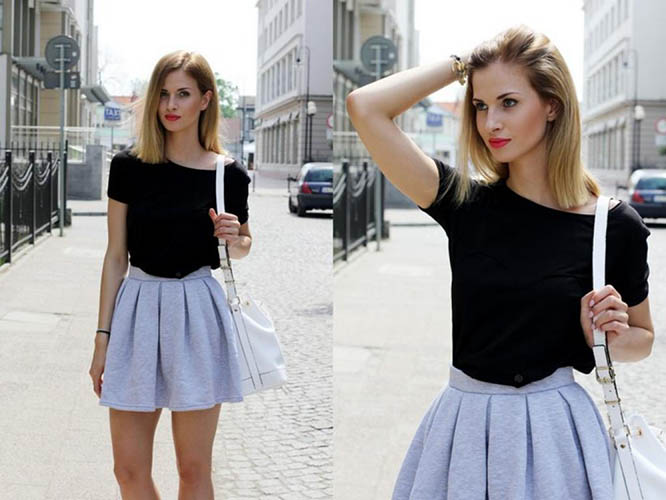
To create a harmonious image, stylists recommend combining a bell skirt with a top devoid of volume, without an abundance of decor and various decorations. This combination will help to even out the silhouette and give it harmonious proportions.
Made from brightly colored fabric, stylists suggest combining these models with a white or cream top and any shoes (except sneakers), both high and low heels.
The bell skirt is a bright and modern model of a basic women's wardrobe. Made according to a fairly simple pattern and popularized by the work of Christian Dior, it was captured in photographs of fashion magazines in the mid-20th century, and does not lose its relevance today, helping to create bright and stylish everyday and romantic women's images.
Video about sewing a skirt
Modeling a bell skirt:
